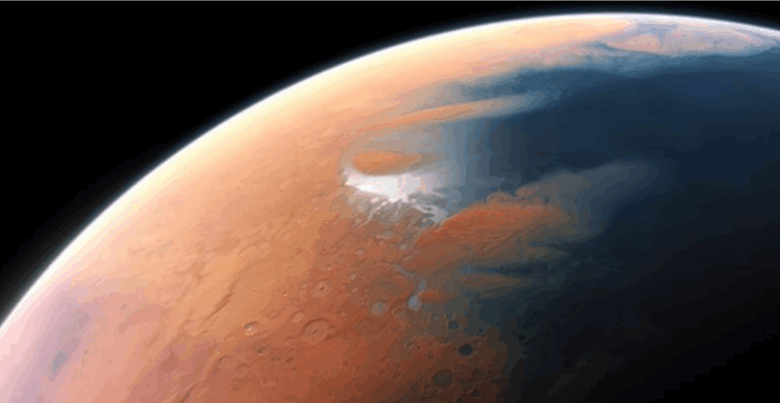New Signals Hint at a Lost Ocean of Water Concealed Within Mars

Evidence is accumulating that a secret lurks beneath the barren red plains of Mars, one that could redefine our view of the Red Planet: a vast reservoir of liquid water, trapped deep in the crust.
Mars is covered in traces of ancient bodies of water. But the riddle of precisely where it all went when the planet turned frigid and desiccated has long intrigued scientists.
Our new study may offer an answer. Using seismic data from NASA’s InSight mission, we uncovered evidence that the seismic waves decelerate down in a stratum between 5.4 and 8 kilometers below the surface, which could be because of the presence of liquid water at these depths.
The mystery of the vanishing water
Mars wasn’t always the desolate desert we see today. Billions of years ago, during the Noachian and Hesperian periods (4.1 billion to 3 billion years ago), rivers carved valleys and lakes shimmered.
As Mars’ magnetic field diminished and its atmosphere contracted, most surface water dissipated. Some escaped to space, some froze in polar caps, and some were confined in minerals, where they remain today.
But evaporation, cooling, and boulders can’t quite account for all the water that must have covered Mars in the distant past. Calculations imply the “missing” water is enough to cover the planet in an ocean at least 700 meters deep, and perhaps up to 900 meters deep.
One hypothesis has been that the absent water trickled into the crust. Mars was severely bombarded by meteorites during the Noachian period, which may have formed fractures that channeled water underground.
Deep beneath the surface, higher temperatures would maintain the water in a liquid state—unlike the icy strata nearer the surface.
A seismic snapshot of Mars’ subsoil
In 2018, NASA’s InSight lander touched down on Mars to listen to the planet’s interior with a super-sensitive seismometer.
By analyzing a particular kind of vibration called “shear waves,” we found a significant underground anomaly: a stratum between 5.4 and 8 kilometers down where these vibrations travel more slowly.
This “low-velocity layer” is most likely highly porous rock filled with liquid water, like a saturated sponge. Something like Earth’s aquifers, where groundwater flows into rock fissures.

We calculated the “aquifer layer” on Mars could contain enough water to submerge the planet in a global ocean 520–780m deep—several times as much water as is held in Antarctica’s ice sheet.
This volume is compatible with estimates of Mars’ “missing” water (710–920m), after accounting for losses to space, water bonded in minerals, and modern ice caps.
Meteorites and marsquakes
We made our discovery owing to two meteorite impacts in 2021 (named S1000a and S1094b) and a marsquake in 2022 (dubbed S1222a). These events sent seismic waves coursing through the crust, like casting a stone into a pond and watching the waves spread.

InSight’s seismometer captured these vibrations. We used the high-frequency signals from the events—think of tuning into a precise, high-definition radio station—to map the crust’s concealed strata.
We calculated “receiver functions,” which are signatures of these waves as they ricochet and reverberate between strata in the crust, like echoes mapping a cave. These signatures let us pinpoint boundaries where rock transforms, disclosing the water-soaked stratum 5.4 to 8 kilometers deep.
Why it matters
Liquid water is essential for existence as we know it. On Earth, microorganisms flourish in deep, water-filled rock.
Could comparable life, perhaps remnants of ancient Martian ecosystems, persist in these reservoirs? There’s only one way to find out.
The water may be a lifeline for more complex organisms, too—such as future human explorers. Purified, it could provide potable water, oxygen, or propellant for rockets.
Of course, excavating kilometers deep on a distant planet is a daunting challenge. However, our data, acquired near Mars’ equator, also points at the possibility of other water-rich zones—such as the frigid sediment reservoir of Utopia Planitia.
What’s next for Mars exploration?
Our seismic data covers only a sliver of Mars. New missions with seismometers are required to map potential water strata across the remainder of the planet.
Future rovers or excavators may one day access these reservoirs, analyzing their chemistry for traces of life. These water zones also require protection from earthly microorganisms, as they could harbor native Martian biology.
For now, the water invites us to keep listening to Mars’ seismic pulse, decoding the mysteries of a world perhaps more like Earth than we imagined. The Conversation
Hrvoje Tkalčić, Professor, Head of Geophysics, Director of Warramunga Array, Australian National University, and Weijia Sun, Professor of Geophysics, Key Laboratory of Earth and Planetary Physics, Institute of Geology and Geophysics, Chinese Academy of Sciences.




